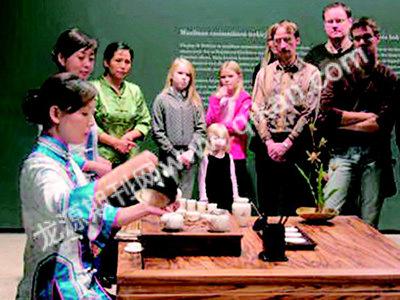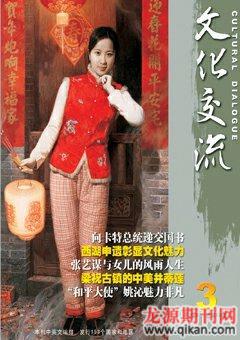Chinese?。裕澹帷。牛穑铩。椋睢。疲椋睿欤幔睿?/h1>
2009-06-30 09:39YeFei
文化交流 2009年3期
Ye Fei

The curtain lifted on the Chinese Tea Culture Exhibition in Finland in October, 2008 when the global economic winter hit the country. But the exhibition, jointly sponsored by China Center for Cultural Exchanges, China Overseas Art Exhibition Center, China Tea Museum of Hangzhou and Tianjin Museum, was not affected by the financial meltdown. It started as scheduled and went on for three months.
The exhibition was held at Espoo Museum of Modern Art (EMMA) at Espoo, the second largest city in Finland. One of the Chinese organizers said that the museum had a preference for Chinese culture, as testified by a successful exhibition of Chinese ethnic garments in 2004.
Mr. Markku Valkonen, curator of the museum, has a profound understanding of the Chinese tea culture. In order to stage a best possible exhibition, experts from the museum visited China five times during the one-year preparations. After visiting museums, watching tea performances and consulting with Chinese experts, they concluded that ancient Chinese tea sets and modern tea performances should be an important part of the exhibition. The Chinese organizers agreed most gladly, saying that the exhibition should be more than tea products on display. They were more than glad to present tea performances and highlight the Chinese tea culture.
Consequently, 119 ancient tea-related artifacts were put up for display in addition to a great variety of tea products. The artifacts spanned nearly 2,000 years, starting from the Han Dynasty (206BC-220AD) up to modern times. The stories they related could be a history of tea in China. The artifacts included utensils made of porcelain, wood and metal, as well as calligraphies and paintings. The arrangements were designed to highlight the evolution of Chinese tea culture.
The opening ceremony started at 6 oclock on the evening of October 7th, 2008 at EMMA, attended by more than 700 VIP guests. On October 11 and 12, tea performances were staged by tea artists from Hangzhou. The performers used an imitation tea table, purchased at a Beijing antique market by Finland experts from the museum. The audiences wowed at the dazzling beauty of the performances. On October 14, the Finland President Tarja Halonen visited the Chinese Embassy in Copenhagen. Chinese diplomats, who had just taken a tea ceremony lesson from experts of Hangzhou at the exhibition, made tea for the president. On October 26th, a lecture on Chinese tea culture was held. Experts from Hangzhou China Tea Museum and Tianjin Museum addressed the six major topics of the Chinese tea culture.
The three-month tea event was the latest effort of the Chinese tea industry to promote the Chinese tea culture in the world. Organizers hoped that the tea exhibition would help people in Finland in particular and Europeans in general better understand Chinese tea culture. The organizers eyed markets in Europe for Chinese tea sets, tea performances and other tea-related trades. Before the tea culture exhibition, most exhibitions on the Chinese tea culture were held in Japan with the focus on either Chinese tea products or the Japanese sado.
Traditional differences made the Chinese organizers wanted more to introduce Chinese tea culture in complete and an unprecedented way. They were fully aware of the cultural difference between Chinese tea and European coffee. Paintings of Chinese sages enjoying a cup of tea with a few friends against a picturesque background were probably too far from the imagination of Europeans who might prefer a cup of coffee with a few friends on a sunny beach or a balcony. Though tea as a beverage is hundreds of years old in Europe, most Europeans regard Chinese tea as a health drink and know little about the rich cultural contents in Chinese tea. They prefer coffee and a cup of coffee can probably last three hours sometimes. □
Ye Fei

The curtain lifted on the Chinese Tea Culture Exhibition in Finland in October, 2008 when the global economic winter hit the country. But the exhibition, jointly sponsored by China Center for Cultural Exchanges, China Overseas Art Exhibition Center, China Tea Museum of Hangzhou and Tianjin Museum, was not affected by the financial meltdown. It started as scheduled and went on for three months.
The exhibition was held at Espoo Museum of Modern Art (EMMA) at Espoo, the second largest city in Finland. One of the Chinese organizers said that the museum had a preference for Chinese culture, as testified by a successful exhibition of Chinese ethnic garments in 2004.
Mr. Markku Valkonen, curator of the museum, has a profound understanding of the Chinese tea culture. In order to stage a best possible exhibition, experts from the museum visited China five times during the one-year preparations. After visiting museums, watching tea performances and consulting with Chinese experts, they concluded that ancient Chinese tea sets and modern tea performances should be an important part of the exhibition. The Chinese organizers agreed most gladly, saying that the exhibition should be more than tea products on display. They were more than glad to present tea performances and highlight the Chinese tea culture.
Consequently, 119 ancient tea-related artifacts were put up for display in addition to a great variety of tea products. The artifacts spanned nearly 2,000 years, starting from the Han Dynasty (206BC-220AD) up to modern times. The stories they related could be a history of tea in China. The artifacts included utensils made of porcelain, wood and metal, as well as calligraphies and paintings. The arrangements were designed to highlight the evolution of Chinese tea culture.
The opening ceremony started at 6 oclock on the evening of October 7th, 2008 at EMMA, attended by more than 700 VIP guests. On October 11 and 12, tea performances were staged by tea artists from Hangzhou. The performers used an imitation tea table, purchased at a Beijing antique market by Finland experts from the museum. The audiences wowed at the dazzling beauty of the performances. On October 14, the Finland President Tarja Halonen visited the Chinese Embassy in Copenhagen. Chinese diplomats, who had just taken a tea ceremony lesson from experts of Hangzhou at the exhibition, made tea for the president. On October 26th, a lecture on Chinese tea culture was held. Experts from Hangzhou China Tea Museum and Tianjin Museum addressed the six major topics of the Chinese tea culture.
The three-month tea event was the latest effort of the Chinese tea industry to promote the Chinese tea culture in the world. Organizers hoped that the tea exhibition would help people in Finland in particular and Europeans in general better understand Chinese tea culture. The organizers eyed markets in Europe for Chinese tea sets, tea performances and other tea-related trades. Before the tea culture exhibition, most exhibitions on the Chinese tea culture were held in Japan with the focus on either Chinese tea products or the Japanese sado.
Traditional differences made the Chinese organizers wanted more to introduce Chinese tea culture in complete and an unprecedented way. They were fully aware of the cultural difference between Chinese tea and European coffee. Paintings of Chinese sages enjoying a cup of tea with a few friends against a picturesque background were probably too far from the imagination of Europeans who might prefer a cup of coffee with a few friends on a sunny beach or a balcony. Though tea as a beverage is hundreds of years old in Europe, most Europeans regard Chinese tea as a health drink and know little about the rich cultural contents in Chinese tea. They prefer coffee and a cup of coffee can probably last three hours sometimes. □

